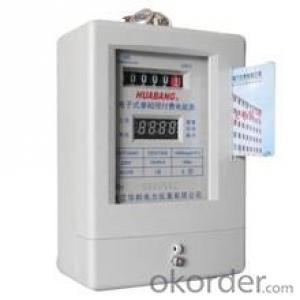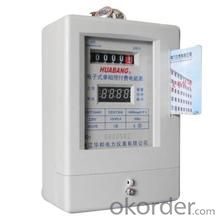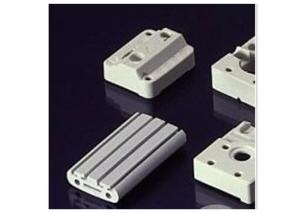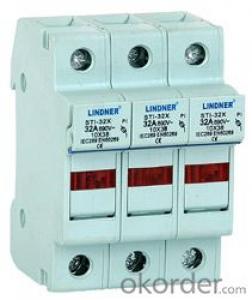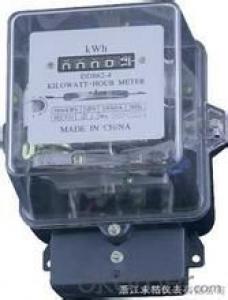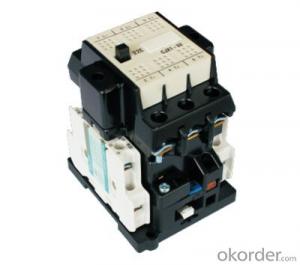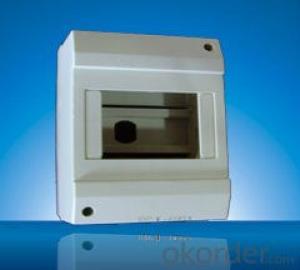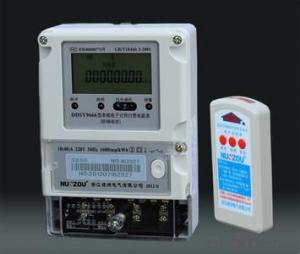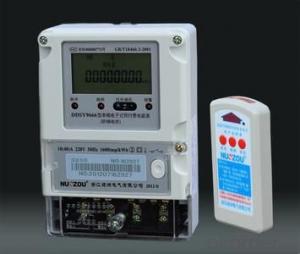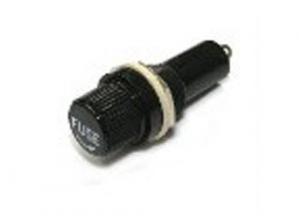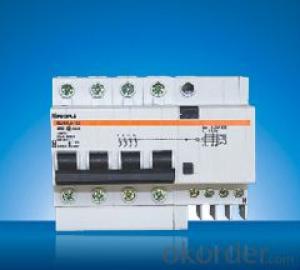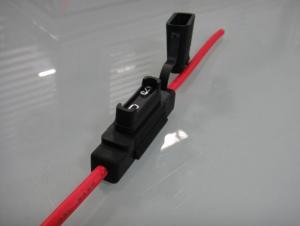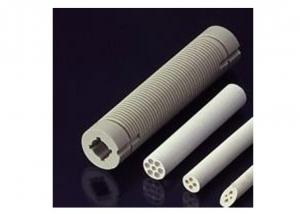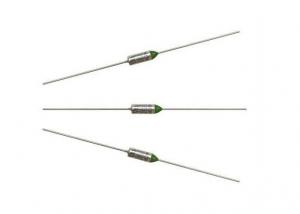DT607、DS607 series three-phase inductance type meters(long life technics)
- Loading Port:
- China Main Port
- Payment Terms:
- TT OR LC
- Min Order Qty:
- -
- Supply Capability:
- -
OKorder Service Pledge
OKorder Financial Service
You Might Also Like
| Application |
DT607、DS607 series three-phase inductance type meteres are used to measure active energy with reference frequency 50Hz. features: low power consumption, high stability, long life. |
| Type and meaning |
| Normal operation and installation conditions |
1、Specified operation temperature range:-25℃~55℃; |
| Construction features |
1、Rotating parts use long life technics:a、use oxidation-proof magnet bearing, no abrasion. b、fixed bearing on and under rotating axis(imported from german) c、use high strength and high rigidity material for up-down bearing pin; d、rotating axis and worm in a same axis to ensure long life operation(more than 25 years). |
| Main technical parameters |
1、Conform to GB/T 15283-1994 and IEC 521-1988 standards; |
| Fype and specifications |
| Outline and installation dimensions |
- Q: I have a 99 mitsubishi eclipse, and recently the radio stoped working, along with the reading lamp that I have. I looked under the hood in the fuse box, and there was a fuse blown, but everytime I put a new one in, it would blow almost right away. What exactly is this caused from, and how can I get it fixed?
- There's a fault with one of the components on the circuit or one of the power wires is grounding to earth (trapped wire/damaged sleeving etc). Identify exactly which items are covered by this fuse and switch all the items off. Change the fuse for a good one, and then switch each component on in turn to see which one causes the fuse to blow. A fairly common fault for aftermarket stereos is for a wire to get trapped between the mounting cage and the chassis of the stereo when it's being pushed into the dashboard, stripping the casing off the wire and causing it to ground to earth. Could also be listening to the stereo too loud (again aftermarket stereos are more likely to be affected) - the extra current to the stereo may cause it to pop the fuse.
- Q: I wrote to the company and they said they can't (or won't) identify the thermal fuse rating, nor will they tell me where to get one. They told me to just buy a new fryer for $50. I don't want to do that, being that I know the fuse costs $2 (I just replaced on my coffee machine). The numbers on the old one are illegible. If I knew the specific rating, I think I could just scoot down to the local Radio Shack and get a new one, like I did for the coffee maker. I can find no service manual anywhere. I assume the rating has to be at least 450 degrees F, but I want to get some more info before replacing what is essentially a fail-safe protection device. If I get on that is rated to high, I run the risk of severely overheating the unit, and I have teenagers who may use it; too low, and it will blow before the oil gets nearly hot enough to fry my chicken. I know I can make the thing operate without the fuse, but I would like to replace it. Any info?
- okorder
- Q: I had lab and I don't quite understand why I did what we did. We used an analog and digital VOM and used it to record the ohms and volts of various electrical components. I was wondering why when using the analog that different devices read completely different ohm readings. Take for example, our Buss fuse didn't even make the needle move, but the diode and the resistor made it go to infinite ohms. How do I figure out what they are supposed to read, and what to expect before going to lab. I couldn't find anything in my book or the lab manual. Also, I was wondering why a resistor would measure outside of its' tolerance range. Is this because it was faulty? Any help is appreciated.
- hmm - the fuse resistance was very low, the diode was infinite 'cos it didn't conduct - it would have done if you reversed the polarity ( turned it round!). This was an experiment - you do not ask what they are supposed to read, it's your job to find out by measuring.!!! That's Physics, not Criminology! The resistor could be out of tolerance, but so what? Just measure it's value as it is now.
- Q: I have a 1998 Honda civic stock altenator I want do a 1200 watt amp it says 120 amps fuses and I want do 2 highs amp 1 300 watt and 1 400 watt will I be ok to hook this up
- In the short term, probably. Long term - I'd be surprised if that alt lasts 6 mo. At anything over 1/2 volume that alt will basically be maxed out. Under that much stress the amount of heat produced will be extreme. Heat in alternators causes both the electrical components and the mechanical components to wear out quickly.
- Q: a motor, a generator, a battery, or a fuse?
- Generator: mechanical to electrical Motor: electrical to mechanical Battery: chemical to electrical Fuse: electrical to thermal, so that it melts to protect other components
- Q: 1991 Honda Civic Si Hatchback. The fuse is hot with car off. It gets an immediate ground short when I turn it on. Wiring schematic says this wire goes directly to ECU. So if it were shorted against body somewhere, it would blow fuse key on of off.Tomorrow I will trace wire directly to ECU and clip it off. If it is ungrounded until I turn on key and then goes to ground when I turn on key, is that sufficient proof that my ECU has an internal short and is junk to be replaced.I hate replacing parts then finding that was not the problem.
- Be careful bec some schematic pgs will only indicate a splice number and not show you that the wire you're trying to trace splices into other wires feeding other devices etc and any other device connected to that same feed either before or after the ECM could cause the fuse to blow.A real good way to usually that either too much load is on a fuse or it is the wrong amp fuse or there is a short is when the fuse blows black.From what you're saying I'am gathering that in fact the fuses are blowing black.Remember that a relay that is over loading or shorting out internally would also cause the fuse that feeds it to blow. Like in any circuit if a certain pin of a module is a input or output voltage the internal circuit would read a certain resistance if you used a ohms meter to the pin and ground and if you got a ohms meter reading that showed a fully closed circuit this would suggest that the ECM has a fault in that circuit.Tests like these are hard to perform bec you have to have the factory specs on such circuits and most don't offer such info in most manuals. Hope that helps and best of luck.By the way trace any wires going to any related relays and going to the ECM bec on an old vehicle like that the wire might be cracked/dry and have bare spots or melted spots especially the harness runs close to any hot spots like the engine etc.Remember that even the voltage regulator can be shorting out. Note if I was trouble shooting that problem I'd use a reset the same amperage as the original factory fuse and I'd use alligator clips/ mini jumper cables to temporary attache the reset to the fuse socket, plus you might use a male plug in flat connector so it can fit into the fuse socket connectors, plus you could solder the wires with the connectors to the reset.Try moving/slightly tugging lightly the different harness's one by one and then then try starting it, if the rest goes it will rest once it cools down a bit.
- Q: i recently got my battery replaced because it wasnt holding charge. when it came out of the shop, the clock, power mirrors, and floodlights arent running. everything else seems fine, and i checked the fuses, all are intact. There were no problems with those 3 components before the battery was replaced. Any Ideas to fix this? thanks
- Did you check the fuse block in the engine compartment. There may be a fuse or relay there that is bad. There may be a spare relay in the box. If this fails, I would go back to the shop and explain it to them. They may have disconnected something and didn't get it hooked back up. Hope this helps and good luck
- Q: I don't want any theories or speculations. I want a real documented electronic device. Oh and no ancient astronaut theories either.
- Diode was the first electronic device.
- Q: A couple of years ago I installed after market speakers in the rear of my car and kept the stock speakers in the front. I connected an amp to the rear speakers. It was working fine but one day I drive my car and notice only the front speakers (the stock ones) are playing. I pop open the hood and notice the amp wire was disconnected from the fuse going into the battery. I reconnect them and turn on the stereo but still there is no sound to the rear speakers. I can hear the tweeters I have make a fuzzing noise, though. Anyone have any ideas on what the problem is?
- Something electrical has happened with the amp. Since it was disconnected, there was likely a sudden instability in the electrical flow, at best only blowing a fuse, at worst blowing a critical internal component in the amp. Check all fuses, if you don't find any blown ones, check the ground cable. Check fuses for the car too, if the hot touched a direct ground, it may have popped one. If still nothing, you are likely looking at serious damage to the amp. If it smells like crispy, it is crispy.
- Q: If you add in cost of each component you will definetly win.Please reply soon. First to answer with good reply will win 10 POINTS!
- no where near enough information. Purpose of circuit, number of additional circuits, are you tying into an existing circuit designing from scratch, Constant circuit, power option circuit (Turn signal, window, alarm) come on throw us a bone here Building a camping stove ehhhh? 12 volt D.C. heavy duty switch 60 ampre should suffice. Around 10 bucks 12 foot spool of 10 guage wire 15 bucks 10 guage inline fuse holder with 50 amp fuse 12 bucks Package of assorted wire ends 14 bucks (or solder and/or soldering iron) price of element unknown (never bought one before) Interstate Battery re-manufactured $25, new $90, deep cycle new $125 60 amp rheostat (to control temperature) 45 bucks Assuming you are talking about a heating element
Send your message to us
DT607、DS607 series three-phase inductance type meters(long life technics)
- Loading Port:
- China Main Port
- Payment Terms:
- TT OR LC
- Min Order Qty:
- -
- Supply Capability:
- -
OKorder Service Pledge
OKorder Financial Service
Similar products
Hot products
Hot Searches
Related keywords
